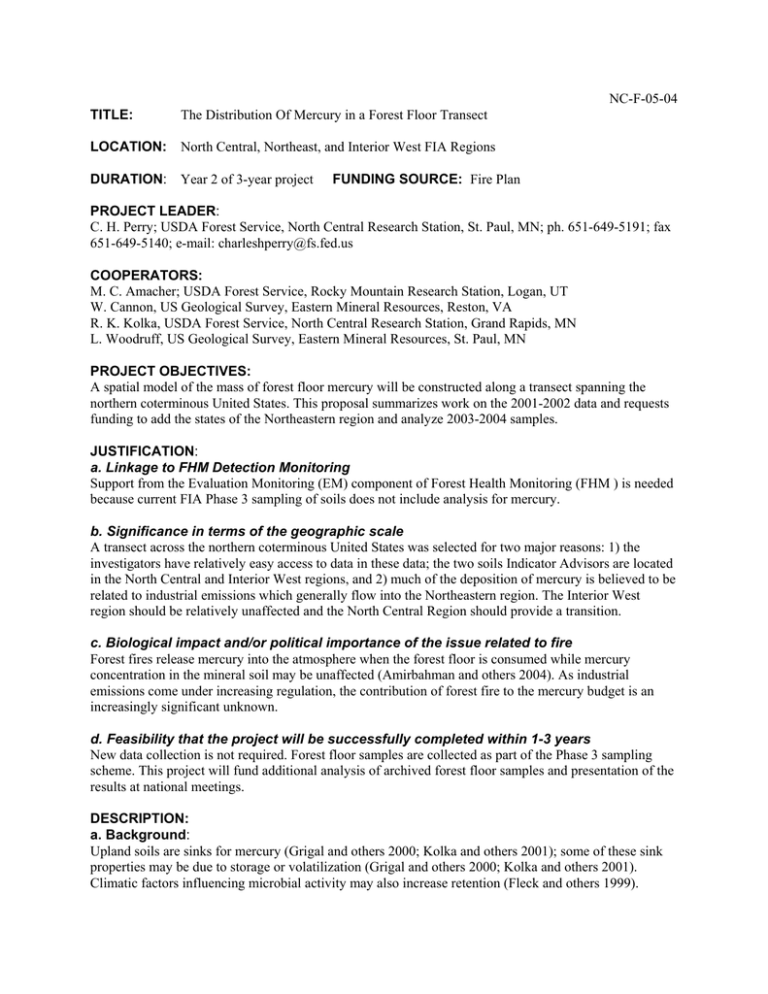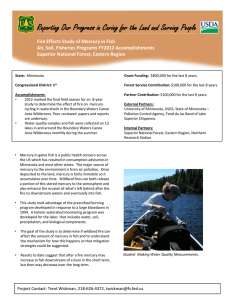NC-F-05-04 The Distribution Of Mercury in a Forest Floor Transect
advertisement

NC-F-05-04 TITLE: The Distribution Of Mercury in a Forest Floor Transect LOCATION: North Central, Northeast, and Interior West FIA Regions DURATION: Year 2 of 3-year project FUNDING SOURCE: Fire Plan PROJECT LEADER: C. H. Perry; USDA Forest Service, North Central Research Station, St. Paul, MN; ph. 651-649-5191; fax 651-649-5140; e-mail: charleshperry@fs.fed.us COOPERATORS: M. C. Amacher; USDA Forest Service, Rocky Mountain Research Station, Logan, UT W. Cannon, US Geological Survey, Eastern Mineral Resources, Reston, VA R. K. Kolka, USDA Forest Service, North Central Research Station, Grand Rapids, MN L. Woodruff, US Geological Survey, Eastern Mineral Resources, St. Paul, MN PROJECT OBJECTIVES: A spatial model of the mass of forest floor mercury will be constructed along a transect spanning the northern coterminous United States. This proposal summarizes work on the 2001-2002 data and requests funding to add the states of the Northeastern region and analyze 2003-2004 samples. JUSTIFICATION: a. Linkage to FHM Detection Monitoring Support from the Evaluation Monitoring (EM) component of Forest Health Monitoring (FHM ) is needed because current FIA Phase 3 sampling of soils does not include analysis for mercury. b. Significance in terms of the geographic scale A transect across the northern coterminous United States was selected for two major reasons: 1) the investigators have relatively easy access to data in these data; the two soils Indicator Advisors are located in the North Central and Interior West regions, and 2) much of the deposition of mercury is believed to be related to industrial emissions which generally flow into the Northeastern region. The Interior West region should be relatively unaffected and the North Central Region should provide a transition. c. Biological impact and/or political importance of the issue related to fire Forest fires release mercury into the atmosphere when the forest floor is consumed while mercury concentration in the mineral soil may be unaffected (Amirbahman and others 2004). As industrial emissions come under increasing regulation, the contribution of forest fire to the mercury budget is an increasingly significant unknown. d. Feasibility that the project will be successfully completed within 1-3 years New data collection is not required. Forest floor samples are collected as part of the Phase 3 sampling scheme. This project will fund additional analysis of archived forest floor samples and presentation of the results at national meetings. DESCRIPTION: a. Background: Upland soils are sinks for mercury (Grigal and others 2000; Kolka and others 2001); some of these sink properties may be due to storage or volatilization (Grigal and others 2000; Kolka and others 2001). Climatic factors influencing microbial activity may also increase retention (Fleck and others 1999). Perry et al. -- Forest floor mercury p. 2 of 4 Forest fires release mercury into the atmosphere when the forest floor is consumed while mercury concentration in the mineral soil may be unaffected (Amirbahman and others 2004). As industrial emissions come under increasing regulation, the contribution of forest fires to the mercury budget is an increasingly significant unknown. b. Methods: Samples of the forest floor are collected as part of Phase 3 sampling in the FIA program. These samples are analyzed for a suite of nutrients and other properties (e.g., total carbon, nitrogen, soil pH). Once the laboratory analysis is complete, the forest floor samples are stabilized and archived in the Grand Rapids lab. We propose to use a remove a small part of the archived sample (< 0.5g) and determine the mercury concentration. This concentration data will be combined with the total mass and depth of the forest floor to estimate the mass of mercury stored in the forest floor. c. Products: The major product will be a spatial model and map of forest floor mercury for a transect across the northern coterminous United States. d. Schedule of Activities: for 2003-2004 samples Fall & Winter 2005-06 Obtain samples Spring, Summer, Fall, Winter 2006-07 Laboratory analysis for mercury Winter & Spring 2007 Create spatial models of mercury storage Spring & Summer 2007 Prepare posters and publications e. Progress/Accomplishments: 2001-2002 samples A copy of our original timeline is included for review purposes. Fall & Winter 2004-05 Obtain samples Spring, Summer, Fall, Winter 2005-06 Laboratory analysis for mercury Winter & Spring 2006 Create spatial models of mercury storage Spring & Summer 2006 Prepare posters and publications We identified samples from the 2001 and 2002 panels across two FIA regions: North Central and Intermountain West (Fig. 1). Samples were identified for three different purposes. First, one subplot was sampled from each plot to define regional variation. Second, every subplot was sampled on 20% of the plots to define within-plot variation. Third, a duplicate 5% sample was removed for QA / QC purposes. Soil archivists removed a small fraction from each sample (< 0.5g) and mailed them to three different laboratories for analysis. Two of the laboratories are operated by the USDA Forest Service, and the third is a contractor with the US Geological Survey. We are using three labs for QA / QC purposes. Laboratory results are expected early in 2006. Perry et al. -- Forest floor mercury p. 3 of 4 Figure 1. Forest floor samples from across the Intermountain West and North Central region (20012002) were submitted for analysis. COSTS: The budget supports 2003-2004 plots in the Intermountain and North Central regions, and all plots from the Northeast. USGS assisted with the 2001-2002 samples, but they currently have no support for this year. Item Administration Procurements Total Salary Overhead Travel Contracting Equipment Supplies Requested FHM EM Funding 0 0 4 000 OtherSource Funding Source 0 0 0 40 250 0 0 0 0 0 44 250 0 REFERENCES: Amirbahman A, Ruck PL, Fernandez IJ, Haines TA, Kahl JS. 2004. The effect of fire on mercury cycling in the soils of forested watersheds: Acadia National Park, Maine, U.S.A. Water, Air, and Soil Pollution 152(1-4):313-331. Fleck JA, Grigal DF, Nater EA. 1999. Mercury uptake by trees: an observational experiment. Water, Air, and Soil Pollution 115(1-4):513-523. Grigal DF, Kolka RK, Fleck JA, Nater EA. 2000. Mercury budget of an upland-peatland watershed. Biogeochemistry 50(1):95109. Kolka RK, Grigal DF, Nater EA, Verry ES. 2001. Hydrologic cycling of mercury and organic carbon in a forested upland-bog Perry et al. -- Forest floor mercury watershed. Soil Science Society of America Journal 65(3):897-905. p. 4 of 4



